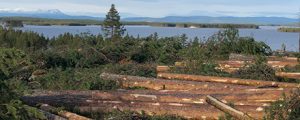The cost of felling in large scale forestry increased by 6% in 2019, according to new statistics from the Swedish Forest Agency. Difficult fellings that were caused by storm and bark beetle infestation affected the cost. Source: Timberbiz
The cost for regeneration felling increased in both northern and southern Sweden during 2019. The largest increase was in southern Sweden by 7% and in northern Sweden costs rose by 5%.
The cost of thinning increased by 4% in northern Sweden. In southern Sweden it instead declined by 4%, back to the same level of 2017.
This survey also includes estimations on fellings that were more difficult because the forest was damaged by fires, storms, insects or fungus. The costs of these difficult fellings were 37% higher than ordinary regeneration felling in 2019. That is a 9 percentage points above the difference in 2018, a year when Sweden had large areas of forest fires.
The most prominent causes of the difficult fellings in 2019 was storm Alfrida, which mostly affected the regions Stockholm and Uppsala, and also the bark beetle infestation in southern Sweden.
The volume of wood from these difficult fellings was about 9% of all the regeneration fellings made by large scale forestry in Sweden in 2019. Without the added costs from the difficult felling, the cost of regeneration felling would have been unchanged or with a small decline compared with 2018.
Over a longer time period, the cost of regeneration felling has increased by 23% from 2009 to 2019. The costs of thinning have also risen, by almost 16% since 2009.
The cost of silvicultural measures (cleaning, scarification, planting and sowing) increased by 3% in northern Sweden and decreased by 1% in southern Sweden compared with the previous year.
Since 2009, the cost of silvicultural measures has increased by 33%. The pre-commercial thinning cost increased by 4% in the north and by 7% in southern Sweden. That is the largest increase in pre-commercial thinning cost in southern Sweden that has been recorded in these statistics, since starting in 1998.
Statistics on costs in large-scale forestry are volume weighted or area-weighted and relate to current prices. Large scale forestry is defined as ownership of more than 16,000 ha forest land or an annual felling of more than 50,000 m³. The survey is a collaboration between the Swedish Forest Agency and the Forestry Research Institute of Sweden.






